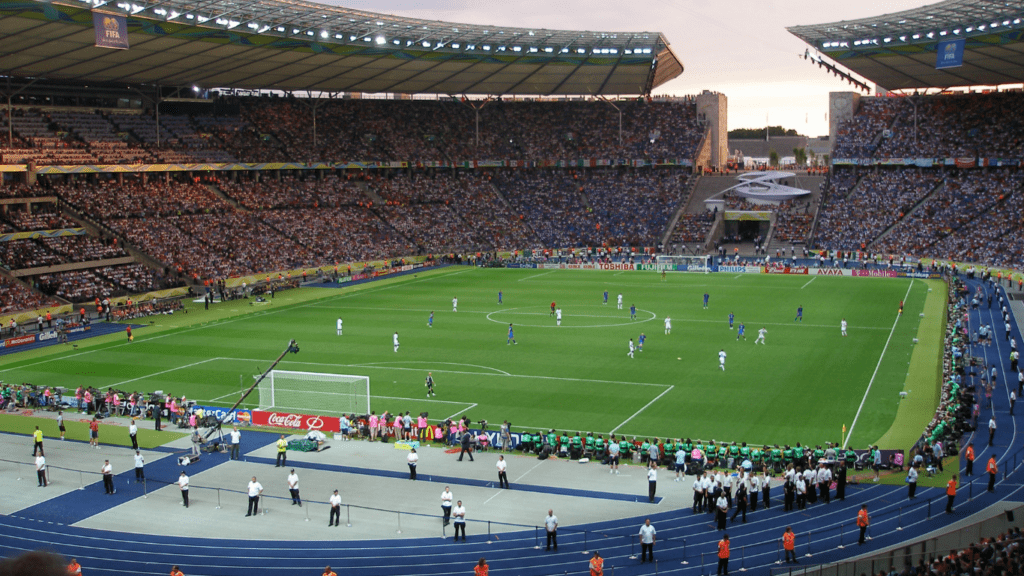Criteria for Evaluating Football Stadiums
Evaluating football stadiums involves several critical factors. These elements define the uniqueness and appeal of each venue.
Architecture and Design
The architecture and design of a football stadium significantly impact its identity. Architectonic elements like:
- roof structure
- façade materials
- overall aesthetic
distinguish one stadium from another.
Examples include the Allianz Arena, known for its inflated ETFE plastic panels, and Camp Nou, recognized for its sheer grandeur and iconic appearance.
Capacity and Facilities
Capacity and facilities play crucial roles in a stadium’s functionality. Stadiums with larger capacities, such as Old Trafford and Santiago Bernabéu, can host more fans.
Modern facilities enhance spectator comfort and convenience. Features like VIP boxes, advanced seating arrangements, and amenities like restaurants and retail spaces contribute to the overall appeal.
Atmosphere and Fan Experience
A stadium’s atmosphere and fan experience define its spirit. The vibrancy of supporters, acoustics, and sightlines all contribute.
Examples include Signal Iduna Park with its Yellow Wall and Anfield renowned for its passionate choir of fans. Stadium layout, acoustics, and immersive experiences like pre-game shows add to this dynamic.
Iconic Football Stadiums in Europe

Europe boasts some of the globe’s most iconic football stadiums. With thousands of fans flocking to these venues, their rich history, unique architecture, and electric atmospheres make them must-visit locations.
-
Wembley Stadium, England
Wembley Stadium, located in London, serves as the ultimate symbol of English football. Housing 90,000 seats, it’s the largest stadium in the UK.
Twin towers defined the previous structure, now replaced by the iconic arch that spans the arena. Hosting the FA Cup Final, key UEFA matches, and numerous concerts, Wembley showcases versatility and grandeur.
Significant matches like the 1966 World Cup Final have contributed to its legendary status.
-
Camp Nou, Spain
Camp Nou in Barcelona is home to FC Barcelona, capable of accommodating 99,354 spectators, making it Europe’s largest stadium. Opened in 1957, it has seen countless historical clashes, including El Clásico.Its design promotes an intimate atmosphere, enhancing fan engagement. The stadium has undergone several upgrades, including the new roof installation, ensuring it remains a modern football haven.
-
Allianz Arena, Germany
Allianz Arena, located in Munich, revolutionized stadium design with its innovative ETFE plastic panels that change color. Home to both FC Bayern Munich and TSV 1860 Munich, it seats 75,024 fans. Opened in 2005, the stadium’s façade can light up in red, white, or blue, reflecting the teams playing.
The technology and architecture make it a standout, offering an unmatched visual experience.
Legendary Stadiums in South America
South America boasts some of the world’s most legendary football stadiums. These venues are not just architectural marvels but also cultural landmarks that host passionate fans and unforgettable matches.
Maracanã, Brazil
Maracanã Stadium in Rio de Janeiro stands as an icon in football history. Opened in 1950, it originally hosted 200,000 fans. Its capacity may have decreased to 78,838 seats, but the atmosphere remains electrifying.
This stadium saw Pelé score his 1,000th goal and hosted the 1950 and 2014 FIFA World Cup finals. Modern amenities and renovations have kept Maracanã relevant to this day.
La Bombonera, Argentina
La Bombonera in Buenos Aires is home to Boca Juniors, one of Argentina’s top football clubs. Its unique shape and steep stands create an intimidating atmosphere for visiting teams.
Opened in 1940 and with a capacity of 54,000, La Bombonera vibrates with the cheers of passionate fans. Highlights include Diego Maradona’s legendary matches and its rich history of Copa Libertadores games.
The stadium is a must-visit for any football fan.
Cutting-Edge Stadiums in North America
North America boasts some of the most advanced football stadiums, combining state-of-the-art design with unparalleled fan experiences.
MetLife Stadium, USA
MetLife Stadium, located in East Rutherford, New Jersey, is an architectural marvel. Opened in 2010, this stadium serves as the home for both the New York Giants and the New York Jets.
With a seating capacity of 82,500, MetLife Stadium ranks among the largest in the NFL. The stadium features cutting-edge amenities, including high-definition video boards and a modern fan engagement zone.
It has hosted major events like Super Bowl XLVIII and WrestleMania, showcasing its versatility.
Estadio Azteca, Mexico
Estadio Azteca in Mexico City is one of the most iconic football stadiums globally, with a rich history dating back to its opening in 1966.
It can hold 87,523 spectators and has witnessed legendary moments, including Diego Maradona’s “Hand of God” goal in the 1986 FIFA World Cup.
The stadium has undergone several renovations to modernize its facilities, ensuring it remains comfortable for fans while preserving its historical significance.
Estadio Azteca continues to host crucial matches for the Mexican national team and Club América.
Innovations in Stadium Technology and Sustainability
Stadiums now incorporate advanced technologies and sustainable practices. Key areas include green building methods and fan engagement technologies.
Green Building Practices
Stadiums integrate eco-friendly materials, use renewable energy sources, and incorporate efficient water management systems. The Mercedes-Benz Stadium in Atlanta uses solar panels and a rainwater collection system.
The Allianz Arena in Munich adopts LED lighting, reducing energy consumption. Levi’s Stadium in California champions recycled materials and green roof designs that improve insulation and reduce heat islands.
Fan Engagement Technologies
Modern stadiums employ technologies that enhance the fan experience. Smart stadium apps offer real-time updates on scores, seat upgrades, and food orders.
Wembley Stadium provides augmented reality (AR) features for interactive experiences. AT&T Stadium in Texas boasts the world’s largest high-definition video screen, ensuring fans don’t miss any action.
Virtual reality (VR) zones let fans immerse in game highlights and behind-the-scenes tours.

